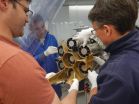(Press-News.org) Glucose is a component of carbohydrates, and the main energy source used by brain cells.
By studying rats, a team at Imperial College London identified a mechanism that appears to sense how much glucose is reaching the brain, and prompts animals to seek more if it detects a shortfall.
The researchers believe it may play a role in driving our preference for sweet and starchy foods.
The study, funded by the Biotechnology and Biological Sciences Research Council, is published in the Journal of Clinical Investigation.
Dr James Gardiner, from the Department of Medicine, who led the study, said: "Our brains rely heavily on glucose for energy. It's clearly a very important nutrient, but in our evolutionary past it would have been hard to come by. So we have a deep-rooted preference for glucose-rich foods and seek them out."
The researchers hypothesised that an enzyme called glucokinase might play a role in driving our desire for glucose. Glucokinase is involved in sensing glucose in the liver and pancreas. It is present in the hypothalamus, an area of the brain that regulates a variety of essential functions including food intake, but its exact role was unclear.
They first discovered that when rats go for 24 hours without eating, the activity of glucokinase in an appetite-regulating centre in the hypothalamus increases sharply.
The rats were given access to a glucose solution as well as their normal food pellets, called chow. When the researchers increased the activity of glucokinase in the hypothalamus using a virus, rats consumed more glucose in preference to chow. When glucokinase activity was decreased, they consumed less glucose.
"This is the first time anyone has discovered a system in the brain that responds to a specific nutrient, rather than energy intake in general. It suggests that when you're thinking about diet, you have to think about different nutrients, not just count calories," Dr Gardiner said.
Dr Gardiner suggested that in humans it might be possible to reduce cravings for glucose by altering one's diet and a drug acting on this system could potentially prevent obesity.
"People are likely to have different levels of this enzyme, so different things will work for different people. For some people, eating more starchy foods at the start of a meal might be a way to feel full more quickly by targeting this system, meaning they eat less overall."
INFORMATION:
For more information please contact:
Sam Wong
Research Media Officer
Imperial College London
Email: sam.wong@imperial.ac.uk
Tel: +44(0)20 7594 2198
Out of hours duty press officer: +44(0)7803 886 248
Notes to editors:
1. Syed Hussain et al. 'Glucokinase activity in the arcuate nucleus regulates glucose intake.' Journal of Clinical Investigation, 2014.
2. About Imperial College London
Imperial College London is one of the world's leading universities. The College's 14,000 students and 7,500 staff are expanding the frontiers of knowledge in science, medicine, engineering and business, and translating their discoveries into benefits for society.
Founded in 1907, Imperial builds on a distinguished past - having pioneered penicillin, holography and fibre optics - to shape the future. Imperial researchers work across disciplines to improve global health, tackle climate change, develop sustainable energy technology and address security challenges. This blend of academic excellence and its real-world application feeds into Imperial's exceptional learning environment, where students participate in research to push the limits of their degrees.
Imperial nurtures a dynamic enterprise culture, where collaborations with industrial, healthcare and international partners are the norm. In 2007, Imperial College London and Imperial College Healthcare NHS Trust formed the UK's first Academic Health Science Centre. This unique partnership aims to improve the quality of life of patients and populations by taking new discoveries and translating them into new therapies as quickly as possible.
Imperial has nine London campuses, including Imperial West: a new 25 acre research and innovation centre in White City, west London. At Imperial West, researchers, businesses and higher education partners will co-locate to create value from ideas on a global scale.
http://www.imperial.ac.uk
Patients with plasma cell dyscrasis have high amounts of an abnormal immunoglobulin, called a paraprotein, in their blood. While many patients have no outward symptoms, paraproteins can impair immune function, thicken blood, and damage organs. Plasma cell dyscrasis may be inherited, but risk factors for this disease are poorly understood. A new study in the Journal of Clinical Investigation suggests that the presence of a modified host protein is associated with plasma cell dyscrasis risk. Michael Pfreundschuh and colleagues evaluated paraproteins in blood from patients ...
Glucose is the primary fuel for the brain. Therefore, it has been proposed that the brain must sense glucose and promote eating behaviors when levels are low. A new study in the Journal of Clinical Investigation reveals that activation of an enzyme, glucokinase, in a region of the hypothalamus called the arcuate nucleus specifically increases glucose uptake. Steve Bloom and colleagues at Imperial College London determined that glucokinase levels in the arcuate nucleus are dramatically increased in fasted rats. In their rodent models, activation of glucokinase in the acruate ...
Saturn's largest moon, Titan, is one of the few solar system bodies - and the only planetary moon - known to have fields of wind-blown dunes on its surface. (The others are Venus, Earth and Mars.)
New research, using experimental results from the high-pressure wind tunnel at Arizona State University's Planetary Aeolian Laboratory, has found that previous estimates of how fast winds need to blow to move sand-size particles around on Titan are about 40 percent too low.
A team of scientists led by Devon Burr of the University of Tennessee, Knoxville reported the findings ...
An enormous spectrum of light streams from the sun. We're most familiar with the conventional visible white light we see with our eyes from Earth, but that's just a fraction of what our closest star emits. NASA regularly watches the sun in numerous wavelengths because different wavelengths provide information about different temperatures and processes in space. Looking at all the wavelengths together helps to provide a complete picture of what's occurring on the sun over 92 million miles away - but no one has been able to focus on high energy X-rays from the sun until recently.
In ...
COLUMBUS, Ohio - When it comes to specialized cancer surgery, it's generally true that the more experienced the surgeon, the better the outcome. The same might hold true for radiation therapy used to treat head and neck cancer, according to a new study led by researchers Evan Wuthrick, MD, assistant professor of radiation oncology at The Ohio State University Comprehensive Cancer Center - Arthur G. James Cancer Hospital and Richard J. Solove Research Institute (OSUCCC - James), and Maura Gillison, MD, PhD, professor of internal medicine and epidemiology at the OSUCCC - ...
A team of researchers at Dartmouth College and University of Pittsburgh found respondents who had smoked water pipe tobacco but not smoked cigarettes were at increased risk of cigarette smoking two years later as recently published online in JAMA Pediatrics. The study followed 2,541 adolescents and young adults for two years.
Samir Soneji, PhD, a tobacco regulatory control researcher at Dartmouth and lead author on the study said, "We found hookah smoking increased the probability of trying cigarette smoking over the next two years by 19%."
This longitudinal study ...
Drinking or eating from cans or bottles lined with Bisphenol A (BPA) could raise your blood pressure, according to new research reported in the American Heart Association's journal Hypertension.
BPA, a chemical used as an epoxy lining for cans and plastic bottles, is everywhere, and its consumption has been associated with high blood pressure and heart rate variability. Previous studies have shown that BPA can leach into foods and drinks.
"A 5 mm Hg increase in systolic blood pressure by drinking two canned beverages may cause clinically significant problems, particularly ...
Nine in 10 primary care physicians say that prescription drug abuse is a moderate or big problem in their communities and nearly half say they are less likely to prescribe opioids to treat pain compared to a year ago, new Johns Hopkins Bloomberg School of Public Health research suggests.
Primary care doctors also appear to recognize many risks of prescription opioid use, including addiction and death by overdose, according to the findings reported in the Dec. 8 issue of JAMA Internal Medicine.
"Our findings suggest that primary care providers have become aware of the ...
A survey of primary care physicians found the vast majority of practicing internists, family physicians and general practitioners consider prescription drug abuse to be a significant problem in their community and most physicians agreed opioids were overused to treat pain, according to a research letter published online by JAMA Internal Medicine.
Primary care physicians are critical in maximizing the safe use of opioid pain-relieving medications. It is because of this that Catherine S. Hwang, M.S.P.H., of the Johns Hopkins Bloomberg School of Public Health, Baltimore, ...
Smoking water pipe tobacco from hookahs and using the smokeless tobacco snus were associated with initiating cigarette smoking and smoking cigarettes in the past 30 days among previously nonsmoking teenagers and young adults, according to a study published online by JAMA Pediatrics.
The Food and Drug Administration regulates cigarettes, loose tobacco and smokeless tobacco products. However, the FDA does not regulate the manufacturing, distribution and marketing of other tobacco products, such as water pipe tobacco, and many of those products are used by teenagers and ...

